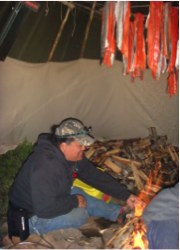The recently produced CTUIR – OSU 2012-2013 Newsletter shares the background, summary, and findings of a collaborative research project to understand polycyclic aromatic hydrocarbon (PAH) exposure related to smoked salmon.

Salmon fillet
Salmon, a first food, is important to the subsistence of Native Americans living in the Pacific Northwest. Smoking salmon is one of the traditional ways to preserve this seasonally abundant food and make it available year round.
People can be exposed to PAHs from breathing contaminated air or eating smoked foods although many other exposure pathways exist.
Each volunteer wore air sampling equipment and turned it on every time they went into the smoking structures.
The data showed the air in the tipi and the smoke shed contained PAHs.



Pictured above from left: Traditional tipi, volunteer tending the fire in the tipi wearing an air sampler in black bag on his hip, traditional smoke shed.
The findings from this study were published in the Journal of Agricultural & Food Chemistry.
B, Harris S, Matzke M, Cardenas A, Waters K, Anderson K. (2012). Effect of Native American fish smoking methods on dietary exposure to polycyclic aromatic hydrocarbons and possible risks to human health. Journal of Agricultural & Food Chemistry, 60(27), 6899-6906. doi: 10.1021/jf300978m
Indigenous cultures perceive the natural environment as an essential link between traditional cultural practices, social connectedness, identity, and health. Many tribal communities face substantial health disparities related to exposure to environmental hazards. We asked 27 volunteers who were members of the CTUIR their opinions on meanings of health and how their environment interacts with their health.
The findings from the focus group discussions were published in the journal Environmental Justice.
Schure M, Kile ML, Harding AK, Harper B, Harris S, Uesugi S, Goins T. Perceptions of environment and health among community members of the Confederated Tribes of the Umatilla Indian Reservation. Environmental Justice. June 2013, 6(3): 115-120. doi:10.1089/env.2013.0022.
In addition, the CTUIR – OSU 2012-2013 Newsletter shares recently appointed members of the Tribal Advisory Board.
We hope you enjoy the newsletter!



